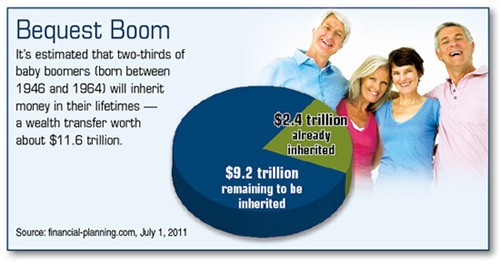The past year was marked by a devastating disaster in Japan, fiscal unravelling in Europe, a highly volatile market, and bitter political infighting over federal spending and the national debt. What’s in store for 2012? No one knows, of course, but the consensus seems to be that the U.S. economy will continue to grow slowly, with slight improvement in employment, little change in the housing market, and interest rates remaining at or near historic lows.1 In short, there may not be much to get excited about. But as 2011 proved, it’s impossible to predict the future. Here are several key areas that bear watching as 2012 unfolds.
European Enigma
A new fiscal pact in December engendered cautious optimism, but the European sovereign debt crisis is far from over. Although Italy and Spain remain a major concern, you might keep tabs on potential downgrading of the credit ratings of other large European economies including France, Austria, and Great Britain.
The European Union is the world’s second-largest economy after the United States and our largest trading partner.2–3 A devalued euro and a weakened European economy could lead to a shrinking market for U.S. exports at a time when the trade deficit has begun to improve — which may impact an already shaky U.S. jobs outlook.4
Although the European situation may require attention, it’s important not to overreact to international events. Investors’ emotions can contribute to market volatility.
GDP and Jobs
Following a very slow start in 2011, the U.S. economy grew at an annual rate of 1.8% in the third quarter. Forecasters project slightly higher growth through the end of 2012.5–6
After hovering around 9%, the unemployment rate unexpectedly dipped to 8.6% in November, the lowest level since March 2009.7 Although this appears to be good news, part of the statistical improvement reflects people who have given up looking for work.8 Many economists see unemployment falling no lower than 8.5% during 2012; but if the downward trend continues, it may mean better times to come.9–10
A major obstacle to job creation seems to be hesitation by U.S. corporations to make capital investments, despite many having larger cash reserves than ever before.11 One factor could be uncertainty over the global economic picture — yet another reason to keep a watchful eye on the European crisis. Another factor may be that the recession led to further utilization of technology and outsourcing to sustain productivity with a smaller U.S. workforce.
Inflation, Interest, and Housing
Inflation (as measured by the consumer price index) is projected to drop into the low 2% range, within the goals of Federal Reserve monetary policy.12 On December 13, the Fed announced its intention to keep the federal funds rate (a benchmark for short-term interest rates) at 0.25% or lower and affirmed its commitment to increasing the average maturity date of its securities — a strategy intended to lower long-term interest rates to stimulate business investment and keep mortgage rates low.13
Some experts question the effectiveness of this strategy because rates on mortgages and business loans are already low. The major drags on the housing market are the large inventory of homes in foreclosure, more rigid lending standards, and the continuing jobs crisis. At best, there may be a slight increase in average housing prices.14
Taxes and Domestic Spending
In late December, Congress passed a two-month extension of the payroll tax cut. Further debate on a year-long extension has the potential to affect consumer confidence and spending.
The scheduled expiration of key tax provisions at the end of 2012 — affecting federal income tax rates, the estate tax, and taxes on capital gains and dividends — could have some impact as the issue heats up later in the year. However, action may not occur until after the November election and could extend into 2013.
Spending cuts mandated by the Budget Control Act may cast a shadow over the economy in 2012 but are not scheduled to take effect until January 2013. Like the tax provisions, action may be delayed until next year.
As with 2011, wild cards might include a natural disaster or political unrest that could affect an already fragile global economy. It’s important to monitor unfolding events, but the soundest approach is generally to follow an investment strategy suited to your personal goals and situation.
Investments are subject to market volatility and loss of principal. Investing internationally carries additional risks such as differences in financial reporting, currency exchange risk, as well as economic and political risk unique to the specific country. This may result in greater share price volatility. Shares, when sold, may be worth more or less than their original cost.
1, 10, 12, 14) The Wall Street Journal’s Economic Forecasting Survey, December 2011
2) CNNMoney, December 16, 2011
3) U.S. Census Bureau, 2011
4, 6, 9) Kiplinger Economic Outlook, December 2011
5) U.S. Bureau of Economic Analysis, 2011
7–8) The New York Times, December 2, 2011
11) The Wall Street Journal, September 16, 2011
13) Federal Reserve, 2011
The information in this article is not intended as tax or legal advice, and it may not be relied on for the purpose of avoiding any federal tax penalties. You are encouraged to visit a
Naperville Tax Advisor or obtain legal advice from an independent professional advisor. The content is derived from sources believed to be accurate. Neither the information presented nor any opinion expressed constitutes a solicitation for the purchase or sale of any security. This material was written and prepared by Emerald. © 2012 Emerald Connect, Inc.






 IRA owners (as well as people who inherit a traditional IRA) who fail to take an RMD could be hit with a 50 percent tax penalty on the amount that should have been withdrawn. IRA beneficiaries are subject to special distribution rules. Spouses typically have more choices than nonspouses.
IRA owners (as well as people who inherit a traditional IRA) who fail to take an RMD could be hit with a 50 percent tax penalty on the amount that should have been withdrawn. IRA beneficiaries are subject to special distribution rules. Spouses typically have more choices than nonspouses.












